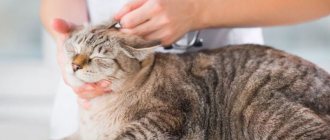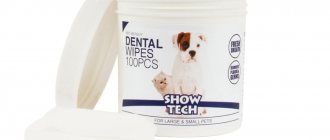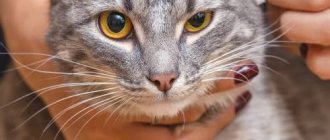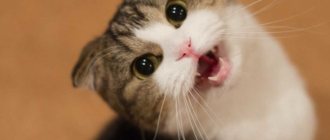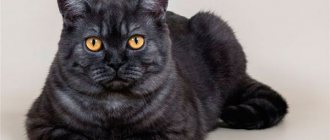Cleaning a cat's ears is a standard procedure, although not everyone performs it at least once in their life. The fact is that some cats do not have problems with sulfur. Ideally, it should come out on its own, and then the cat simply removes it with its paws when washing itself. But this is not the case for everyone: some cats have a feeling that a whole sulfur pit is opening up in their heads. As a result, the pet scratches its ears all the time, tries to clean them, shakes its head, as it is unpleasant and ticklish for him. In this case, the owner must help the ward.
Let’s immediately say that the answer to the question of how to clean the ears of a fold-eared cat or kitten is the same as for all other breeds. It's done exactly the same way. That is, how to clean the ears of lop-eared kittens or a cat does not depend on the shape of the auricle. For all cats, there are two methods. There are two points of view. Some veterinarians believe that there is no need to go into the ears at all, and that they should only be wiped superficially and only when the dirt is too noticeable. Others advocate deep ear cleaning if your cat is producing too much wax. Let's look at these two methods.
Article continues after advertisement
Is it possible to clean your ears at home?
Unlike yard animals, breeds created in artificial conditions require constant care. There are areas of their life in which they simply cannot take care of themselves properly. Scottish fold kittens are no exception. Quite a lot is known about their ear problems.
If fold-eared kittens have their ears cleaned only in a veterinary office, this will create some financial difficulties for their owners. In fact, this process is not so difficult that you cannot master it and then carry it out on your own at home.
First, you should accustom your pet to such procedures. It is worth remembering that a cat is able to remember the owner’s lengthy preparations when he is about to clean her ears. This can cause stress in the animal, which will encourage the pet to constantly hide.
To avoid such an unpleasant situation, it is important to keep all means within easy reach, and you should only examine and clean the kitten’s ears when it is in a relaxed state. You can stroke and caress him first, and then it won’t hurt to treat your pet with something tasty or reward him in another way. By fulfilling these conditions, you can reduce the kitten’s stress and make the task easier for yourself.
Special breeds – special approach
The Sphynx and Siamese cat breeds are distinguished by large ears, on which there is almost no hair. In addition, these cats produce sulfur more intensively, since a larger area needs to be protected. Therefore, the problem of removing accumulations of dirt and wax from a cat’s ears arises quite often. Dust and wax form a dark brown coating in the ear canal, accumulating in unsightly clumps. And if the ears of cats of other breeds can be cleaned after 2-3 weeks, then big-eared purrs will have to be accustomed to weekly inspection and cleaning.
In the ears of lop-eared Scots and British women, the wax has a light shade, so it is not visually noticeable. This is where a small flashlight will be indispensable. After all, it is necessary to notice in time when there is too much sulfur and it will threaten the cat’s delicate hearing. Clean the ears with the same swabs and cotton swabs using lotion.
In the ears of lop-eared Scots and British women, the wax has a light shade
Persian cats, on the other hand, have thick and abundant fur. Combined with the tendency for wax to accumulate quickly, this also creates a problem. Therefore, these pussies will have to be examined and cleaned once a week.
If you do not neglect the hygiene of the animal, then your pets will not have problems with the ears. This means that your pet will be in the best shape and in a great mood.
How often to perform the procedure
An important factor is how often the ears of fold-eared cats need to be cleaned. First of all, it depends on the individual characteristics of the pet. The owner should periodically check the condition of the kitten's ears and clean them if wax deposits are obvious or there are other contaminants.
Don't forget to wipe your ears after bathing, as stagnant water can cause illness. In general, fold-eared kittens have their ears cleaned at least once every 2 months. You shouldn’t be overzealous with hygiene either. This kind of care will not give the kitten’s body the opportunity to develop immunity against germs. And then even the slightest infection in the ears can cause infection.
How and with what to clean your ears
Although some people like to use ear sticks, this method of cleaning them is considered quite dangerous, since using such a device can go quite deep. In this case, there is a risk of damaging the inner ear, which will affect the cat’s hearing, so cotton pads are recommended for the procedure.
Hydrogen peroxide is considered a common method for cleaning the sink from dirt, but cleaning the ears of Scottish Fold kittens with this product is not particularly recommended. This substance may irritate the delicate skin of babies. Therefore, as an alternative, it is necessary to use special lotions that will effectively clean the skin of the kitten’s ears.
To clean the ears of a fold-eared kitten, you need to carefully turn them out. This is a mandatory condition, without which nothing will work in this case. Now all that remains is to remove the layer of dirt. You must be prepared that after the procedure your baby will shake his head and rub his ears with his paws for some time. This is a completely natural reaction that goes away after a couple of hours.
To summarize: ear hygiene is an important part of cat care. This is especially true for fold-eared breeds. To carry out the procedure correctly, you can first consult a veterinarian. It is important to choose the right products and prepare your pet for the procedure. You need to clean your ears regularly, but not too often. This will protect your furry friend from otitis media and other dangerous diseases.
Source
Cat breeds characterized by increased sulfur production
Cornish Rex kitten
In cats, the hearing organs are structured in the same way as in humans, and consist of three main sections. The outer part contains the auricle itself, the middle section contains the eardrum and special auditory ossicles that help the animal catch sound. The inner ear consists of nerve canals and the vestibular apparatus necessary for orientation in space. Despite the same structure, the hearing system in cats is much better developed than in humans.
These amazing animals are able to perceive ultrasonic vibrations inaccessible to the human ear. Cats determine the distance to a sound source literally down to a centimeter. The ability of pets to turn their ears 180 degrees allows them to catch more sounds.
American Curl
- American Curl;
- sphinx;
- Cornish Rex;
- Scottish lop-eared;
- Persian;
- British;
- Ukrainian Levkoy.
Ukrainian Levkoy
Cats with large ears will need to be treated daily, while cats with fold ears will need to be treated a little less often. Persians, British and lop-eared Scots are more prone to the formation of earwax than others. They need to carry out the procedure at home weekly, but ear sticks cannot be used so as not to damage the eardrum. It is easier to do this with a special lotion and a cotton pad.
Finally, I would like to dwell on breeds whose genetic characteristics have endowed their representatives with a specific ear structure. Such cats need a special approach and more complex tactics for cleaning the ears.
Breed Care Features
Scottish fold cat
The famous “folded” ears of the Scots should be checked frequently for possible dirt and inflammation at least three times a week
Ukrainian Levkoy
A hairless cat with large, high-set ears, slightly curved forward, acting as real “dust collectors.” Wax quickly accumulates in the ears of left-handed cats and needs to be cleaned.
Lop-eared munchkin
The mutations affected not only the limbs of the breed, but also the ears, which require careful care to prevent suppuration and inflammation. It is advisable for munchkins to undergo bath procedures in hats
Pudelcat
The wide-set ears of the representatives of the breed are folded in the same way as those of Scottish Fold cats, but do not fit so tightly to the head. There are also poodle cats with classic ears - caring for them is no different from usual
American Curl
Representatives of the breed are famous for their ears, which are curved at ninety degrees and point outward.
When cleaning curls' ears, it is important not to damage the fragile cartilage, and therefore their ears should not be straightened or pulled out.
Elf
The ears of the representatives of the breed really look like elven ones - widening at the base and tapering towards the end, they smoothly bend back, forming an arch. Ear hygiene requires gentle handling of cartilage, which can become deformed under the pressure of the owner.
Dwelf
Dwelfs are the sum of several breeds at once, such as the Munchkin, Sphynx, American Curl
A complex pedigree gave the representatives of the breed a unique appearance and uniquely complex ear care, which inherited all the mutations of their “ancestors”
Caring for the ears of Scottish cats, or How to clean a cat's ears?
Cleaning a cat's ears is a standard procedure, although not everyone performs it at least once in their life. The fact is that some cats do not have problems with sulfur. Ideally, it should come out on its own, and then the cat simply removes it with its paws when washing itself. But this is not the case for everyone: some cats have a feeling that a whole sulfur pit is opening up in their heads. As a result, the pet scratches its ears all the time, tries to clean them, shakes its head, as it is unpleasant and ticklish for him. In this case, the owner must help the ward.
What not to do
It is necessary to perform manipulation only on the visible part; attempts to penetrate deeper will only do harm.
There is no need to use folk remedies or self-prepared solutions that can dry out the epidermis and cause allergies.
Some breeders perform it to perfect purity. This is far from correct. Earwax should be present in moderation.
Also, do not use self-made devices. Is it dangerous. Leads to injury and infection.
Method No. 1: clean only the outside
The argument in favor of cleaning the cat's ears only from the outside, that is, without getting into the ear canal with chopsticks, is the desire not to damage it, not to introduce an infection there, and not to compact the wax into the plug. The latter is possible if you make incorrect movements that are directed inward and not outward. In addition, there is a risk that a piece of cotton wool will remain in the ear canal.
How to clean the ears of lop-eared kittens is no different from cleaning the ears of straight-eared kittens. But lop ears need regular cleaning, because... The shape of the ears does not contribute to the self-cleaning of the external auricle. At the beginning of the procedure, you should bend the ear, turning it inside out. Don't worry: the cat is not hurt, although he is unhappy. Some folds cannot really turn their ear out, because... their ears are too small. Then you will have to hold the ear by the tip with your fingers so that it does not fall back.
Then you need to spray a special product into the ear canal, which can be purchased at a veterinary pharmacy or pet store. Such a product, if the cat’s ears are healthy and cleaning is only preventive, should not contain antibiotics. Wax-softening liquids are best. It is difficult to remove sulfur dry, but with this substance everything goes like clockwork. After you have sprayed the cat into the ear canal 1-2 times (at this time you need to hold the cat tightly by the head so that he does not shy away from it), you should massage the ears to distribute the product inside. Then let the cat shake its head: at this time, the liquid along with sulfur will come out. After that, all that remains is to remove the wax from the auricle with cotton swabs or a disk.
Lifehack
It's a rare cat who likes to have his ears cleaned. Most often, pets consider this action as unauthorized access to their holy of holies, along with the anus or testicles. Therefore, you have to act accurately and correctly. To begin, sit the cat on your lap, stroke it, caress it. During the procedure, talk to him gently at all times.
The cat will not just let you do something with it. Most often, he will press his ears back - as a result, you will not be able to put anything there. Plus the cat will back away to run away and rub its head with its paws, because... he's ticklish. To prevent the cat from running away, you can put his butt next to your body - now there is nowhere to back away. In extreme cases, you will have to squeeze it with your feet or wrap it in a blanket like a shawarma. In some cases you have to call for help.
To stop the cat’s attempts to press its ears and prevent you from performing manipulations in this way, you need to immediately turn the ear outward: this does not hurt the cat, but it gives a beautiful view of the auricle. After the procedure, reward your cat with a treat so that the procedure is associated with a pleasant ending.
Method No. 2: clean inside
It happens that a cat produces too much wax, and all of it does not leave the ear canal quickly enough. In this case, no matter how some veterinarians criticize it, you will have to clean the ear canal. To do this, it is advisable not to take a flexible ear stick, but to wrap cotton wool, for example, around an operating clamp: the clamp does not bend, and therefore it will not be able to enter to the end of the ear canal if the cat suddenly jerks its head violently. You can’t wrap it around scissors: the cotton wool can come off and you will injure your pet’s ear.
Before getting into your ear, you need to do the same with ear drops as in the previous method, that is, spray it into your ear, massage it, shake your head, and only then start cleaning. You need to remove wax from the ear canal using gentle movements from the inside out along the walls of the canal. The auditory canal of cats is curved, so it is difficult to damage the eardrum: you simply cannot reach it. But it’s not worth pushing the stick too far. After cleaning the inside, you need to wipe the outer ear.
This method is very helpful for those cats in which, on the 2-3rd day after cleaning their ears, wax accumulates again and comes out because too much of it is produced. The method helps you forget about cleaning your cat’s ears for several days, or even a week.
Features of the structure of the animal's auricle
A cat’s ear, like a person’s, consists of 3 sections:
- External: a funnel-shaped auricle, covered on the inside with a small amount of guard hairs and on the outside with hair, and the external auditory canal.
- Middle: includes the eardrum and the bony tympanic cavity, where the 3 auditory ossicles are located. They play one of the leading roles in the perception of sound.
- Internal: hollow bone formation in the temporal bone, the most complex section. It contains the receptor channels of hearing and the vestibular apparatus.
In humans, the auditory canal is straight and short, but in cats it bends and runs slightly at an angle. Due to ignorance of this feature, during cleaning you can create a sulfur plug that will block the passage.
The cat's ear can detect vibrations from 20 to 100,000 Hz. With the help of muscles and cartilage, the auricle rotates in different directions, which allows you to accurately determine the source of sound. All this makes animals excellent hunters.
Earwax formation and its role in the ear canal
The formation of sulfur is not a pathology, but a natural process. The ear secretion performs several important functions:
- lubricates and moisturizes the skin in the ear canal;
- provides protection against bacteria and fungi;
- prevents the ingress of dust, hair and skin particles, and insects.
All debris that enters the ear, thanks to the sulfur, clumps and comes out naturally. The cat brushes off the residue while washing.
If the production of wax is impaired, pathogenic bacteria easily enter the ear, causing animals to develop:
- otitis;
- dermatitis;
- otomycosis (fungal infection) and other diseases.
In healthy animals, earwax has a paste-like consistency, is light brown in color, and has virtually no odor. Changes in color, thickness, or the appearance of an unpleasant odor indicate the onset of the disease.
Ear cleaners
There are a huge number of preparations for cleaning cat ears. Suitable products can be purchased at a pharmacy or veterinary store. Which remedy to choose depends on the problem at hand.
| Means | Mode of application |
| veterinary ear lotion | quickly removes all possible contaminants, has not only a disinfectant, but also an immunostimulating effect, strengthens local immunity, thereby reducing susceptibility to viral and bacterial diseases |
| pharmaceutical drug "Chlorhexidine" | a popular antiseptic that effectively removes any contaminants without irritating the mucous membranes |
| veterinary drops | “Bars” is a preventive remedy, “Bars Forte” is for the treatment of fungal and inflammatory diseases of the ears, “Veda” is a drug suitable for irritated and sensitive skin |
| chamomile infusion or tea leaves | a good replacement if you can’t buy a veterinary product |
| boiled water | used for simple preventative cleaning |
| hydrogen peroxide and soapy water | These products should not be used, they contain irritating and corrosive components that can cause allergies, injure the eardrum, and cause deafness in a Scottish kitten |
ATTENTION! If rubbing the ears of a Scottish kitten is not therapeutic, but prophylactic, then you should not buy medications containing antibiotics.
Step-by-step instructions on how to clean the ears of fold-eared kittens
The best option is to take your Scottish kitten to a veterinary clinic, where a specialist will carefully clean the ears. But it is not always possible and financial resources to use the services of a veterinary specialist. In this case, you have to act independently at home.
In general, cleaning the ears of Scottish Fold kittens is no different from the procedure performed for cats of other breeds. That is, the method of cleaning curved ears is the same as straight ones.
Veterinarians have two opinions about cleaning cat ears. Some experts believe that it is necessary to clean both the outer and inner parts of the ears, others convince that it is enough to clean the outside of the ears, but there is no need to go inside.
Internal ear cleaning is justified only when too much dirt and wax has accumulated, which often happens in lop-eared kittens, or when the animal has become infected with ear mites.
The owner decides which cleaning method to choose. It is important to carefully prepare for the procedure:
- Choose a time when the Scottish kitten feels good, is not nervous, and is not sick.
- Before cleaning, caress your pet and stroke it so that it makes sure that everything is in order and feels safe. You can’t worry, he will feel it, he will start to rush about, worry, and scratch.
- Prepare tools and equipment: hygiene product, cotton swabs and pads, clean cloth napkins.
The owner must be prepared for the fact that the Scottish pet will not allow his ears to be touched so easily. Usually cats press their ears to their head with muscles to close the inner surface of the ears from the owner.
Also, the kitten will probably back away and squirm. He will vigorously shake his head and rub his ears with his paws to relieve the tickling when the owner tries to penetrate with a stick.
In this case, the Scottish pet needs to be placed with its tail towards you, and its body held between your legs. Then the baby will not break free and will not be able to back away. Some Scottish cats resist so much that their owners have to wrap them in a towel or blanket.
Below we detail how to clean the inside and outside of the ears of Scottish Fold kittens.
External cleaning only method
Some veterinarians advise cleaning a Scottish Fold kitten's ears only from the outside, without pushing the cotton swab deep into the ear canal, so as not to accidentally injure the internal parts of the hearing organ.
If you use the stick incorrectly, you can drive the wax plug deep into the inner ear, injure the eardrum, or cause an infection. There is also a risk that the cotton wool will come off the stick and remain deep in the ear canal.
The ears of Scottish Fold pets need to be cleaned regularly, because curved ears, unlike straight ones, do not self-clean from wax and dirt. Carry out the external cleaning procedure as follows:
- Bend the auricle inside out. There is no need to worry, the kitten does not experience pain, although discomfort is possible if the ear is pulled too far.
- Holding the kitten's head, the surface of the ear is treated with the purchased product. For external treatment, liquid preparations that soften the sulfur crust are optimal.
- The ears are pressed to the head with your fingers and massaged for 2–5 minutes so that the applied product is evenly distributed. During the massage, it is advisable to stroke the neck or behind the ear of the Scottish kitten with your second hand so that it relaxes and does not worry.
- Allow the kitten to shake its head freely so that the softened wax moves away from the skin.
- Then the wax plaque is removed from the surface of the ears with a cotton pad.
- Wipe the surface of the ears dry with a clean napkin and release the kitten.
Internal cleaning method
A feature of Scottish Fold cats (Scottish Folds) is the abundant production of earwax, which slowly comes out and accumulates in the ear canal. Therefore, contrary to the opinion of some veterinarians, the ears of Scottish pets need to be cleaned inside as well.
You should not use a cotton swab for this purpose: it is flexible, and the cotton wool is not firmly attached to it. If the kitten jerks its head during the procedure, the cotton wool may end up inside the ear canal, and removing it will be problematic. It is better to tightly wrap the cotton wool onto a stiff stick with a blunt end.
IMPORTANT! Do not wrap the cotton wool around the scissors. If it slips, the sharp end of the tool may injure the cat's inner ear organs.
The procedure for cleaning the inside of a Scottish Fold kitten's ears is as follows:
- At the first stage, the outer surface of the auricle is treated with a liquid ear remedy, as in the previous method, massaged, and the kitten is allowed to shake its head.
- Then they begin cleaning. Sulfur accumulations are pulled out of the ear canal with extreme care. Make lifting movements and pull it out along the wall of the ear canal. It is strictly forbidden to press the wax mass deep into the ear.
- Due to the curvature of the cat's ear canal, it is almost impossible to injure the eardrum unless you push the stick too deep. It is enough to process a passage 1 cm deep.
- After thorough internal cleaning, wipe the outer surface of the auricle according to the method described earlier.
- Wipe the surface of the ears dry with a napkin and release the animal.
How often does a cat need ear care?
You should take care of your Fold at least once a week, as its droopy ears are prone to getting dirty. A Scottish kitten needs to be accustomed to the procedure from an early age, then, as an adult, he will not perceive cleaning as something scary and unpleasant.
Cleaning should be carried out even if wax and dirt in the ears are invisible. Firstly, preventive cleaning is no less important than therapeutic cleaning. And secondly, regular cleaning will allow the kitten to get used to it faster. If your pet's ears are absolutely clean, you can even simply wipe them with boiled water.

